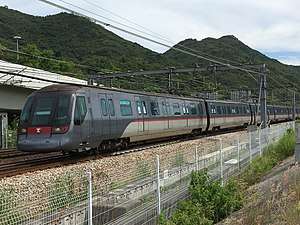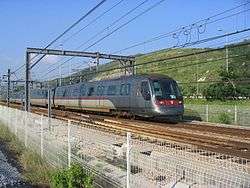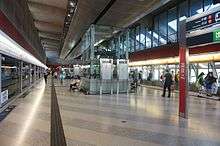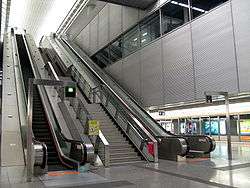Tung Chung line
The Tung Chung line is one of the eleven rapid transit lines of the MTR system in Hong Kong, linking the town of Tung Chung with central Hong Kong. A part of the Tung Chung line was built along with the Kap Shui Mun Bridge and the Tsing Ma Bridge. The line currently travels through eight stations in 27 minutes along its route. The line is coloured orange on the map.
Tung Chung line 東涌綫 | |||||||||||||||||||||||||||||||||||||||||||||||||||||||||||||||||||||||||||||||||||||||||||||||||||||||||||||||||||||||||||||||||||||||||||||||||||||||||||||||||||||||||||||||||||||||||||||||||||||||||||||||||||||||||||||||||||||||||||||||||||||||||||||||||||||||||||||||||||||||
|---|---|---|---|---|---|---|---|---|---|---|---|---|---|---|---|---|---|---|---|---|---|---|---|---|---|---|---|---|---|---|---|---|---|---|---|---|---|---|---|---|---|---|---|---|---|---|---|---|---|---|---|---|---|---|---|---|---|---|---|---|---|---|---|---|---|---|---|---|---|---|---|---|---|---|---|---|---|---|---|---|---|---|---|---|---|---|---|---|---|---|---|---|---|---|---|---|---|---|---|---|---|---|---|---|---|---|---|---|---|---|---|---|---|---|---|---|---|---|---|---|---|---|---|---|---|---|---|---|---|---|---|---|---|---|---|---|---|---|---|---|---|---|---|---|---|---|---|---|---|---|---|---|---|---|---|---|---|---|---|---|---|---|---|---|---|---|---|---|---|---|---|---|---|---|---|---|---|---|---|---|---|---|---|---|---|---|---|---|---|---|---|---|---|---|---|---|---|---|---|---|---|---|---|---|---|---|---|---|---|---|---|---|---|---|---|---|---|---|---|---|---|---|---|---|---|---|---|---|---|---|---|---|---|---|---|---|---|---|---|---|---|---|---|---|---|---|---|---|---|---|---|---|---|---|---|---|---|---|---|---|---|---|---|---|---|---|---|---|---|---|---|---|---|---|---|---|---|---|---|
 Tung Chung line train approaching Sunny Bay station | |||||||||||||||||||||||||||||||||||||||||||||||||||||||||||||||||||||||||||||||||||||||||||||||||||||||||||||||||||||||||||||||||||||||||||||||||||||||||||||||||||||||||||||||||||||||||||||||||||||||||||||||||||||||||||||||||||||||||||||||||||||||||||||||||||||||||||||||||||||||
| Overview | |||||||||||||||||||||||||||||||||||||||||||||||||||||||||||||||||||||||||||||||||||||||||||||||||||||||||||||||||||||||||||||||||||||||||||||||||||||||||||||||||||||||||||||||||||||||||||||||||||||||||||||||||||||||||||||||||||||||||||||||||||||||||||||||||||||||||||||||||||||||
| Type | Commuter Rail | ||||||||||||||||||||||||||||||||||||||||||||||||||||||||||||||||||||||||||||||||||||||||||||||||||||||||||||||||||||||||||||||||||||||||||||||||||||||||||||||||||||||||||||||||||||||||||||||||||||||||||||||||||||||||||||||||||||||||||||||||||||||||||||||||||||||||||||||||||||||
| System | MTR | ||||||||||||||||||||||||||||||||||||||||||||||||||||||||||||||||||||||||||||||||||||||||||||||||||||||||||||||||||||||||||||||||||||||||||||||||||||||||||||||||||||||||||||||||||||||||||||||||||||||||||||||||||||||||||||||||||||||||||||||||||||||||||||||||||||||||||||||||||||||
| Locale | Districts: Central and Western, Yau Tsim Mong, Sham Shui Po, Kwai Tsing, Tsuen Wan, Islands | ||||||||||||||||||||||||||||||||||||||||||||||||||||||||||||||||||||||||||||||||||||||||||||||||||||||||||||||||||||||||||||||||||||||||||||||||||||||||||||||||||||||||||||||||||||||||||||||||||||||||||||||||||||||||||||||||||||||||||||||||||||||||||||||||||||||||||||||||||||||
| Termini | Hong Kong Tung Chung | ||||||||||||||||||||||||||||||||||||||||||||||||||||||||||||||||||||||||||||||||||||||||||||||||||||||||||||||||||||||||||||||||||||||||||||||||||||||||||||||||||||||||||||||||||||||||||||||||||||||||||||||||||||||||||||||||||||||||||||||||||||||||||||||||||||||||||||||||||||||
| Stations | 8 | ||||||||||||||||||||||||||||||||||||||||||||||||||||||||||||||||||||||||||||||||||||||||||||||||||||||||||||||||||||||||||||||||||||||||||||||||||||||||||||||||||||||||||||||||||||||||||||||||||||||||||||||||||||||||||||||||||||||||||||||||||||||||||||||||||||||||||||||||||||||
| Ridership | 236,900 daily average (weekdays, September 2014)[1] | ||||||||||||||||||||||||||||||||||||||||||||||||||||||||||||||||||||||||||||||||||||||||||||||||||||||||||||||||||||||||||||||||||||||||||||||||||||||||||||||||||||||||||||||||||||||||||||||||||||||||||||||||||||||||||||||||||||||||||||||||||||||||||||||||||||||||||||||||||||||
| Operation | |||||||||||||||||||||||||||||||||||||||||||||||||||||||||||||||||||||||||||||||||||||||||||||||||||||||||||||||||||||||||||||||||||||||||||||||||||||||||||||||||||||||||||||||||||||||||||||||||||||||||||||||||||||||||||||||||||||||||||||||||||||||||||||||||||||||||||||||||||||||
| Opened | 21 June 1998 | ||||||||||||||||||||||||||||||||||||||||||||||||||||||||||||||||||||||||||||||||||||||||||||||||||||||||||||||||||||||||||||||||||||||||||||||||||||||||||||||||||||||||||||||||||||||||||||||||||||||||||||||||||||||||||||||||||||||||||||||||||||||||||||||||||||||||||||||||||||||
| Depot(s) | Siu Ho Wan | ||||||||||||||||||||||||||||||||||||||||||||||||||||||||||||||||||||||||||||||||||||||||||||||||||||||||||||||||||||||||||||||||||||||||||||||||||||||||||||||||||||||||||||||||||||||||||||||||||||||||||||||||||||||||||||||||||||||||||||||||||||||||||||||||||||||||||||||||||||||
| Rolling stock | |||||||||||||||||||||||||||||||||||||||||||||||||||||||||||||||||||||||||||||||||||||||||||||||||||||||||||||||||||||||||||||||||||||||||||||||||||||||||||||||||||||||||||||||||||||||||||||||||||||||||||||||||||||||||||||||||||||||||||||||||||||||||||||||||||||||||||||||||||||||
| Technical | |||||||||||||||||||||||||||||||||||||||||||||||||||||||||||||||||||||||||||||||||||||||||||||||||||||||||||||||||||||||||||||||||||||||||||||||||||||||||||||||||||||||||||||||||||||||||||||||||||||||||||||||||||||||||||||||||||||||||||||||||||||||||||||||||||||||||||||||||||||||
| Line length | 31.1 km (19.3 mi) | ||||||||||||||||||||||||||||||||||||||||||||||||||||||||||||||||||||||||||||||||||||||||||||||||||||||||||||||||||||||||||||||||||||||||||||||||||||||||||||||||||||||||||||||||||||||||||||||||||||||||||||||||||||||||||||||||||||||||||||||||||||||||||||||||||||||||||||||||||||||
| Track gauge | 1,432 mm (4 ft 8 3⁄8 in) | ||||||||||||||||||||||||||||||||||||||||||||||||||||||||||||||||||||||||||||||||||||||||||||||||||||||||||||||||||||||||||||||||||||||||||||||||||||||||||||||||||||||||||||||||||||||||||||||||||||||||||||||||||||||||||||||||||||||||||||||||||||||||||||||||||||||||||||||||||||||
| Electrification | 1.5 kV DC | ||||||||||||||||||||||||||||||||||||||||||||||||||||||||||||||||||||||||||||||||||||||||||||||||||||||||||||||||||||||||||||||||||||||||||||||||||||||||||||||||||||||||||||||||||||||||||||||||||||||||||||||||||||||||||||||||||||||||||||||||||||||||||||||||||||||||||||||||||||||
| Operating speed | 135 km/h (84 mph) | ||||||||||||||||||||||||||||||||||||||||||||||||||||||||||||||||||||||||||||||||||||||||||||||||||||||||||||||||||||||||||||||||||||||||||||||||||||||||||||||||||||||||||||||||||||||||||||||||||||||||||||||||||||||||||||||||||||||||||||||||||||||||||||||||||||||||||||||||||||||
| |||||||||||||||||||||||||||||||||||||||||||||||||||||||||||||||||||||||||||||||||||||||||||||||||||||||||||||||||||||||||||||||||||||||||||||||||||||||||||||||||||||||||||||||||||||||||||||||||||||||||||||||||||||||||||||||||||||||||||||||||||||||||||||||||||||||||||||||||||||||
| Tung Chung line | |||||||||||||
|---|---|---|---|---|---|---|---|---|---|---|---|---|---|
| Traditional Chinese | 東涌綫 | ||||||||||||
| Literal meaning | East (of a) branch of a river — 東涌 | ||||||||||||
| |||||||||||||
History
In October 1989, the Hong Kong government announced plans to build a new airport on the remote island of Chek Lap Kok to replace the overcrowded Kai Tak International Airport at the heart of Kowloon.
As part of the initiative, the government invited the MTR Corporation to build a rail link to the new airport dubbed the Lantau Airport Railway. The project initially saw opposition from the Chinese government as it feared the construction would drain the monetary reserve of the Hong Kong government and leave the Chinese with nothing after the British handed the territory over in 1997.
Both the Chinese and British governments reached an agreement and construction commenced in November 1994.
The Lantau Airport rail link consists of two train lines, the Tung Chung line and the Airport Express. Both lines deploy the same rolling stock with minor differences in interior fittings and liveries.
On 21 June 1998, the Tung Chung line was officially opened by Chief Executive Tung Chee-hwa, and service commenced the next day.
On 16 December 2003, an open house for charity took place at the recently completed Nam Cheong station, an interchange between the Tung Chung line and soon to be opened West Rail line. The station then closed on 19 December 2003 in preparation for the opening of the new West Rail Line, and it was officially opened to public on 20 December 2003. Since then, the number of cars per train has increased from seven to eight to accommodate the additional patronage.
Sunny Bay station opened on 1 June 2005 as an interchange for the Disneyland Resort line. The resort opened its door two months after the station became operational.
Between 2006 and 2007, four new trains entered service to improve service frequency. The first train was delivered on 9 February 2006 and entered service on 12 June 2006. Modifications were added to the platforms to accommodate the new trains, which are a few millimetres wider than the original rolling stock.
Route map
 MTR Tung Chung line and Airport Express route map |
Route description
Unlike most other railway lines in the system, the Tung Chung Line travels mostly above ground and spans a greater distance. The line shares its trackage with the Airport Express before diverging in Tung Chung.
The line travels underground from Hong Kong station to Kowloon station across the harbour, then surfaces to the ground to reach Olympic station. Trains continue to travel above ground along the West Kowloon Expressway and stops at Nam Cheong station, followed by Lai King station on a viaduct. Thereafter the line crosses the Rambler Channel and stops at Tsing Yi station on Tsing Yi Island.
Trains then enter a tunnel through the hills of the island and continues on the Tsing Ma Bridge and the Kap Shui Mun Bridge onto Lantau Island. The line continues along the North Lantau Expressway and stops at Sunny Bay before terminating at Tung Chung. The distance between the two stops is roughly 10 km and takes approximately 6 minutes to complete.
Some outbound trains do not continue to Lantau but terminate at Tsing Yi station due to the capacity constraint of the Tsing Ma Bridge which only allows one train to pass at all times.[2]
- Tung Chung line Train at Sunny Bay station
 Tung Chung line A-Stock Train
Tung Chung line A-Stock Train Tung Chung line K-Stock Train
Tung Chung line K-Stock Train Tung Chung line K-Stock Train
Tung Chung line K-Stock Train- Exterior of Tung Chung station
 Upper platform level of Lai King station
Upper platform level of Lai King station
 Nam Cheong station; interchange with West Rail line
Nam Cheong station; interchange with West Rail line Olympic station concourse
Olympic station concourse Kowloon station, Tung Chung line platform
Kowloon station, Tung Chung line platform Hong Kong station, Tung Chung line platform
Hong Kong station, Tung Chung line platform
Stations
The following is a list of the stations on the Tung Chung line.
| Livery and name | District | Connections | Opening date | |
|---|---|---|---|---|
| Tung Chung line | ||||
| Hong Kong | Central and Western | Airport Express Central station for Tsuen Wan line and Island line |
22 June 1998 | |
| Kowloon | Yau Tsim Mong | Airport Express | ||
| Olympic | ||||
| Nam Cheong | Sham Shui Po | West Rail line | 20 December 2003 | |
| Lai King | Kwai Tsing | Tsuen Wan line | 10 May 1982 (Tsuen Wan line) 22 June 1998 (Tung Chung line) | |
| Tsing Yi | Airport Express | 22 June 1998 | ||
| Sunny Bay | Tsuen Wan | Disneyland Resort line | 1 June 2005 | |
| Tung Chung | Islands | Ngong Ping Cable Car | 22 June 1998 | |
Design limitations
At the time when the then colonial administration announced its plans to build the airport rail link, the Chinese government voiced concerns of the project's significant capital outgoings. In 1994, a few years before the handover, both British and Chinese governments reached an agreement on the conditions of the following cost saving measures:[3]
- The airport rail link was originally designed to accommodate four tracks, two each for the Airport Express and Tung Chung Line. It was later reduced to two tracks where both services share the same trackage. As a result, signal failures can affect both services.
- Reduction on train traffic capacity on Tsing Ma Bridge, Ma Wan Viaduct, and Kap Shui Mun Bridge) means only one train can travel on either direction on any given time. The minimum headway between trains comes to 2 minutes 15 seconds, and forces some Tung Chung Line services from crossing the bridges into Lantau and terminate at Tsing Yi.
- The signalling system is not capable of giving priority to the limited-stop Airport Express trains. Tung Chung Line trains would sometimes stop at Sunny Bay Station for an extended period of time to give way to the Airport Express trains.
- The power supply system restricts the number of trains running between Kowloon and Lai King stations. The system can accommodate a maximum of one Airport Express train and two Tung Chung trains travelling on both directions at one time. The minimum headway on this section of the line is 3 minutes 30 seconds.
Future development
Island extension
Once the North Island line is complete, trains will travel in a tunnel east of Hong Kong station along the shore of the island before merging into Tseung Kwan O line at North Point. Three new stations, Tamar, Exhibition Centre and Causeway Bay North, will form part of the extension.
Tung Chung Line Extension
Tung Chung East and Tung Chung West In April 2020, Carrie Lam and the Executive Council approved the detailed planning and design of the Tung Chung Line Extension project. It is scheduled to begin construction in three years, while the cost of the two new Stations, Tung Chung East and Tung Chung West, are expected to cost HK$18.7 billion. This extension is expected to be complete by 2029.
Track Extension near Hong Kong Station
Meanwhile, an underground tunnel, around 1/2 km long, will be built Eastwards of Hong Kong station to allow Tung Chung Line and Airport Express trains to turn around, allowing the trains to easily switch directions, thus enhancing the efficiency of operations.
The project is expected to extend the line an additional 1.5 kilometers. The contract for the extension was recently awarded to British engineering companies Arup and Atkins.
See also
| Wikimedia Commons has media related to Tung Chung line. |
- List of areas of Hong Kong
- Transport in Hong Kong
References
- "Weekday patronage of MTR heavy rail network from September 1 to 27 and September 28 to October 25, 2014" (PDF). Legislative Council of Hong Kong. 29 October 2014. Retrieved 15 April 2015.
- "Legislative Council Panel on Transport, Subcommittee on Matters Relating to Railways, Airport Railway Capacity" (PDF). Legislative Council of Hong Kong. 17 November 2009. Retrieved 21 July 2017. Cite journal requires
|journal=(help) - (in Chinese)MTR Service Update (26 November 2012). "為甚麼東涌綫總是班次疏落?". Retrieved 28 November 2012.
